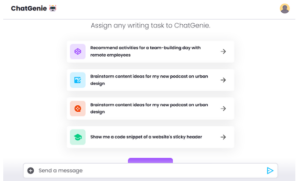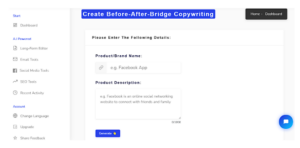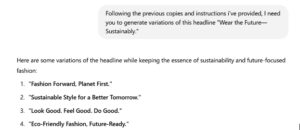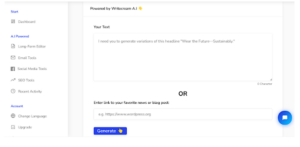Fancy email template designs, expensive downtown banners, and time-sensitive social media promotions. These are all effective ways to grab attention.
However, what truly drives conversions is the message delivered through your ad and email copy. These words speak directly to your audience’s desires, needs, and pain points.
But here comes the problem—generating these copies at scale and consistently at the same quality. Manually, that’s like running uphill with a truckload as your backpack, especially when trying to convert leads. Difficult.
With AI? That’s a walk in the park. AI writing tools like WriteCream help you craft the right message, both in quantity and quality, guaranteeing they resonate with your audience.
In this article, we’ll share the steps to writing high-converting ads and emails with these GenAI tools.
Why AI Copywriting is a Game-Changer for Marketers
Content has always been at the forefront of every marketing game. That’s what sells your products and services. However, an average person sees about 98.5 ads and probably more than 126 emails daily. Optimization of your content is crucial for better engagement.
Adrian Iorga, Founder and president of Stairhopper Movers, says that’s too much content for anyone to consume in just 24 hours.
“To ensure your emails and ads are not buried under the content noise out there, you need to create copies that truly move the needle and superiorly compete for your customer’s attention. And you need to create them at scale”, he continues.
But that’s impossible without hiring more hands—which is rather costly. According to Glassdoor, an average copywriter charges about $60,000 to $120,000 yearly, which could be reduced through effective optimization. Imagine building a team of two or more.
On the other hand, AI copywriters cost just a decimal, not even a fraction, of that, making them a best practice for budget-conscious marketers. For instance, WriteCream’s AI copywriting tool—for emails, Google ads, social media ads, or even blogs— costs just $4 to $8 monthly.
That’s a steal!
With just an editor and AI-powered copywriting tools like Writecream, your marketing team can overperform compared to those not using AI.
Real-World Examples of High-Converting Ads That Convert
In digital marketing, real-world examples of high converting ads that convert can be game-changers for any digital marketer looking to improve ad performance. One standout ad example is a video ad that uses a compelling testimonial and a clear call to action to guide potential customers through the funnel. These types of high-converting Facebook ads rely on strong ad creativity, strategic ad design, and a powerful value proposition that resonates with the audience. When you create high-converting Facebook ads, it’s essential to include lead ads, retargeting strategies, and multiple CTAs to drive the clicks.
A good example of a facebook ads incorporates a video ad showing real user results, a bold headline, and a sense of urgency in the call to action—all while staying visually aligned with your ad creative. To create facebook ads that convert, it’s important to use facebook’s robust targeting tools to reach potential customers and implement retargeting for those who didn’t initially take action. Many Facebook ads that convert feature a clean ad design, engaging video ad content, and highlight the value proposition upfront. When creating high-converting Facebook ads, pairing your ad creative with a relevant landing page enhances the user experience and maximizes conversions.
Whether you’re trying to create high-converting campaigns for social media marketing or simply looking for examples of high-converting Facebook ads, studying high-converting Facebook ad examples will inspire better ad creation and boost high conversion rates. Remember, consistency in ad creative, clear call-to-action, and showcasing testimonials can be the difference between a scroll and a click—or a high-converting ad creative that captures attention.
9 Steps to Craft High-Converting Ads and Email Copies
Writing good copies with AI is not rocket science. Here’s how to do it right.
Feed your AI good copies
Do you know what conditioning means?
According to Molly Ancel, Managing Partner at Peerpoint Property Solutions, “It’s like setting the stage for a desired outcome by consistently reinforcing certain inputs or behaviors. But in this case, it refers to stuffing your AI with good ad and email copies so it learns patterns to improve its performance.”
This is possible because AI tools utilize Machine Learning, reinforcement learning, and adaptive algorithms to form habits—yes, like humans.
So, if you want good copies:
- Go online; that is, social media, websites, email boxes, and so on
- Use social media analytics to identify trends and engagement metrics
- Select your best-performing ad and email copies
- Feed them into your AI writing tool and tell it to analyze the pattern
- Instruct it to leverage similar patterns, but modified to be better, in creating your copies
“You can also condition your AI with competitors’ best-performing copies to enhance your ad spend effectiveness. For instance, you can search for the leading Coca-Cola advertisements, extract the messaging, and prompt your tool to dissect it. You only need the AI to take what worked and incorporate it into your ad copies too”, Leon Huang, CEO at RapidDirect, shares.
Since you’re not planning to reproduce the exact concept, there shouldn’t be any risk for content copyright.
Generate mindblowing ideas
Now, your AI thinks like you. Well, maybe not the same way, but enough to act as a brainstorming buddy for mindblowing ideas. To effectively pass your message across, you need to generate an ad idea or email template that grabs real attention.
The idea you work with now also shapes your copy’s narrative and guides how you hook your audience later on in your high-converting ad creative. This is an example of ad or email copy ideas you can produce after conditioning your AI tool.

WriteCream’s ChatGenie lets you generate tons of similarly awesome ideas with or without all the conditioning we’ve talked about before, enhancing your ad campaign. You can either go ahead and craft your copies with the AI assistant tool after deciding on the idea or structure to use.

Or you can export these ideas into WriteCream’s Google Ad and Email copy tool for a fillup.

Design prompts that yank out creativity
If you’re using tailored tools like WriteCream’s Google, Facebook, and email ad copy tools, just your brand’s name and product description will suffice to generate jaw-dropping copies. But if you’re using other AI writing tools, you need good prompts to yank out creativity.
For instance, prompts like, “Give me two ad copy ideas for my new hairband product” sound too generic and will probably bring back generic responses too, which won’t convert well in your Facebook ad campaigns.
But what if you refine it into something like: “Generate two ad copy ideas for a stylish, no-slip hairband designed for active women to use in a Facebook ad campaign. It should highlight comfort, durability, and how it keeps hair in place during workouts.”
Test the prompts that yield more results and note them down for future use.
The more detailed and unrestricted your prompts are, the more creatively amazing your AI can get.
Write in sections (Your headline variations first)
With the existing instructions you’re provided, the ideas previously generated, and your overpowered prompts, you’re ready to create just almost anything. But take it stepwise—start with the headlines.
If you followed the second step and generated ideas for your copy, you should have a headline ready for your single ad. But that’s just the initial concept. You need to create variations and see which one actually passes the right intent.
See the image below:

“Look Good. Feel Good. Do Good” looks succinct and sounds sharp. For a fashion brand targeting GenZs and millennials, this works really well.
WriteCream’s headline generator makes this process easier and faster by analyzing your competitors’ pages or reference headlines and coming up with a creative hit.

Follow up with a strong hook
Rob Gold, VP of marketing Communications at Intermedia, says, “Hooks are responsible for maintaining the attention your headline has already grabbed. It sets a mood for the entire copy; once you blow it, your copy is just a string of texts.”
Similar to what we did before, you can feed your AI a bunch of intriguing hooks relevant to your product or brand and ask it to give something better.
Or you can simply ask your AI tool to follow up the headline with a strong hook, like below, to optimize your ad campaign.

Keep your audience hooked with a great body
We have the headline and a good hook. What’s next is the storyline or your copy’s body. Usually, this contributes to the most headache if you’re manually writing the copy for a carousel ad. But your AI should have no problem dishing out some real good, storytelling-imbibed results leveraging previous history to create engaging image or video ads.
Before going ahead, you need to provide the format of copy to use in writing your body. This could be the Before-After-Bridge copy method or the Pain-Agitate-Solution approach. For it to work well, you can provide templates depicting these methods and how your AI tool can leverage the same for your copy’s body.
Alternatively, you can just use WriteCream’s already configured Before-After-Bridge and Pain-Agitate-Solution copy tools to get the job done, especially when creating ads on Facebook.

End your copies with a fairy CTA
“Your CTA closes the deal. Prompt your AI to include emotional triggers like FOMO, desire for status, happiness, and urgency in your ads on Facebook. Of course, you should avoid FOMO words like ‘Act Now,’ ‘Limited Time Offer,’ ‘Hurry,’ ‘Don’t Miss Out,’ and ‘Exclusive Deal. ’ They can land your email in the graveyard of all emails—spambox,” Raihan Masroor, Founder & CEO at Your Doctors Online, says.
Also, create variations just like you did for your headline. You should have enough product or service options to choose from. Examples include:
- Don’t Wait—Make a Difference Now!
- Last Chance for Guilt-Free Fashion!
- Be the Change—Shop Before It’s Gone!
Add that final human touch
Joel Popoff, CEO at Axwell Wallet, agrees that “AI is great; there’s no doubt about that. But AI is fallible, just like humans, and can misinterpret the call to action. So, go through the first draft and check for things like tone, styles, fallacies due to AI hallucinations, grammar errors, and unwarranted claims in your effective ad. humor, slang that don’t fit in, and so on.”
You can also restructure sentences or statements to align more with your brand’s messaging. The little emotions and conjunctions here and there make your copies feel more human. Once that’s done, hit the publish button for your Facebook ad campaigns.
Use A/B testing to compare performance and refine
Finally, A/B testing for different outputs should be implemented to see which copies perform better. That’s possible by measuring KPIs like email open rate, conversion rate, clickthrough rates, engagement rate on ads, and social proof.
Note down what’s different about the high-performing emails—maybe it’s the headline, prompts used, hook, or body. Then, implement these insights to generate better outputs next time and improve your conversion rate.
Advertising tools like Google Ads and email platforms like MailChimp provide A/B testing resources. However, you can also use third-party platforms, such as Convertize and Zoho PageSense.
Wrapping Up
AI is revolutionizing marketing by empowering your teams to create ad and email copies that resonate with your audience. For maximum results, condition your AI tool with your best-performing copies and also with those from competitors. Start your copies in sections rather than asking your tool to yank out everything at once.
Prioritize strong hooks and attention-grabbing headings. Prompt AI to use copywriting methods such as “Before-After-Bridge” and “Pain-Agitate-Solution” for a compelling body. And end it with a human touch.
Or you can just use WriteCream’s already configured email and ad copywriter to achieve the same—maybe better—results. Sounds great? You can start here.

